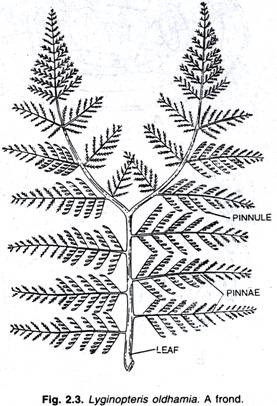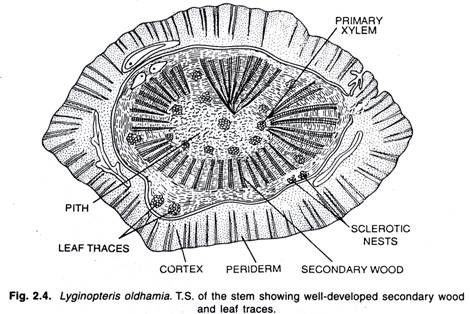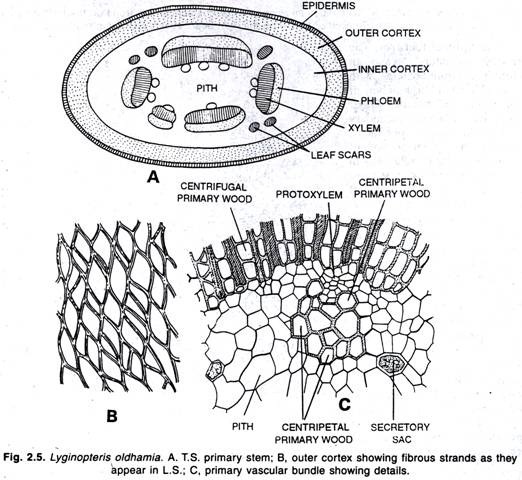Let us learn about Lyginopteris. After reading this article you will learn about: 1. Systematic Position of Lyginopteris 2. Features of Lyginopteris 3. Reproductive Structure 4. Seed 5. Phylogenetic Relationships.
Systematic Position of Lyginopteris:
Gymnosperms
Class. Cycadopsida
Order. Pteridospermales
Family. Lyginopteridaceae
Genus. Lyginopteris
(Calymatotheca)
The genus Lyginopteris also known as Lyginodendron.
Features of Lyginopteris:
1. Morphological Features:
The stem Lyginopteris was slender and covered with large scaly leaves. Near the base of the plant adventitious roots developed. The plant seems to have been a climber.
Lyginopteris oldhamia also known as Calymatotheca hoeninghausi was described in detail by Williamson, Scott, Brongniart, Binney, Potonie, and Oliver and Scott. It was found abundantly in the coal ball horizon of Lancashire and Yorkshire.
2. Anatomical Features:
The Primary structure was an ectophloic siphonostele with large pith round a number of primary mesarch bundles. Older plants showed normal secondary growth. In some specimens, however, the xylem portion of primary vascular bundles was in a continuous ring. In some there was an abnormal type of secondary growth.
This abnormality was of two forms, either there was an inner ring of secondary phloem developed or it was that the cambium appeared in strips found separately in vascular bundles giving rise to a polystelic appearance.
Reproductive Structure of Lyginopteris:
Some of these Palaeozoic leaves bore microsporangia on them. The fertile pinnules were more or less peltate in form and on their underside they bore usually six sporangia. These sporangia are usually bilocular. Such a type has been described as Crossotheca type.
The microspores seem to have formed a male prothallus. The sperms seem to have been of like those of present-day cycads.
Seed of Lyginopteris:
The best known seed has been described under the name Lagenostoma. These seeds were small in size, only about 1/4 but they were highly organized. It was barrel shaped and whole seed enclosed in cupule. This cupule opened out when seed was mature.
Each seed was borne at the tip of stalk. The cupule rose from the base of the seed but not fused with it. The cupule was in three main lobes. These lobes were divided in the upper parts of the seeds. The seed or ovule was orthrotropus and of cycadian type. It was radially symmetrical.
The cupule was separated from the seed along its entire length. The seed itself has an integument which surrounded the nucellus. The integument and nucellus were fused except at the top. The integument formed nine projections. In each of these projections there was a vascular bundle present. These projections surrounded the nucellar beak.
The pollen grains then came to lie in pollen chamber formed by disorganization of some of nucellar tissue round the base of nucellar beak.
In some of preparations the megaspore membrane is very well seen. In the centre of the seed there was a tissue but so far neither any archegonium nor any embryo has been found in these Palaeozoic seeds.
The seeds were borne at the tips of the stalks. They were not organized to form cover. In addition to this Lagenostoma there are many other Palaeozoic seeds which have been described some simpler other more complex than Lagenostoma.
A peculiar feature of all Palaeozoic seeds which so for has not been explained is the absence of any embryo in them. Pollen grains have been found in pollen chambers. Some of them had even showed their germ tube, but so far no seed is discovered in which embryo was developed. It is possible that all the seeds described might have not preserved or they preserved before embryo formation.
Phylogenetic Relationships of Lyginopteris:
We find that the xylem in the case of pteridophytes show only scalariform thickening on it. In Cycads we find the pitted type of thickening on it. It is seen that the xylem of some cycads passes through scalariform stage and one recent cycad Stangeria, here the xylem shows only scalariform thickening in tracheids.
There were no pits. On account of the absence of pitted thickening the genus Stangeria was for a long time included among ferns, and it was only later when a plant was found bearing seeds on it that it was shifted from ferns to Cycadales.
The stem of Cycadofilicales has combined structure of both ferns and cycads. In Cycadofilicales arranged from protostelic to polystelic structure and there is found only in some of lower types like Marattia, Angiopteris, Ophioglossum and Botrychium. These Cycadofilicales in appearance were like the ferns. In Carboniferous times the vegetation was very much like most of present day ferns.
It was due to the strong resemblance in the external features that the group was described as Cycadofilicales. It was later on when seeds of Lagenostoma were found growing on leaves Lyginopteris that fern connection of the group came to an end.
English workers (Oliver and Scott) call the group Pteridosperms. They are of opinion that they belong to an extinct group of pteridophytes which has developed seeds on them. American workers called the group as Cycadofilicales. They think that the group has distinct affinities with ferns on one hand and Cycadales on other hand also.
The fossil leaves found in Carboniferous strata cannot be suitably assigned either to the ferns or to Cycadofilicales. With more advancing knowledge more and more of these Corboniferous leaves are coming to be associated with Cycadofilicales, and some workers have even gone so far to say that during the Carboniferous the ferns were not at all common and they did not exist in those times.
Some of the more primitive type of ferns probably did exist in those times but so far known all those types were homosporous. Heterospory probably developed only in Cycadofilicales.
These Cycadofilicales are of course definitely related to ferns in the general appearance of plant, the form of leaves, the general anatomy of stem and particularly in the form of microsporangia which in the two groups are very much alike the features which separate the Cycadofilicales from the ferns in a more complex stem anatomy with secondary growth and the presence of seed structure.
The origin of this seed structure has not been explained so far. There is no direct evidence with regard to the evolution of structure. There is only guess work, this seed habit must have preceded heterospory. It must have from some heterosporous plants that the Cycadofilicales had originated.
We know all bryophytes and primitive ferns are homosporous.
It is only a few types of present day pteridophytes like Selaginella and heterosporous ferns that heterospory is seen, it appears that the two groups pteridophytes and Cycadofilicales have originated from some common ancestral group in which heterospory had come into existence or it may be that homosporous ancestral ferns may have given rise to pteridophytes and the heterosporous one to the Cycadofilicales.
So clearly the Cycadofilicales must have come from some heterosporous ancestors, but so far no such fossil has been discovered. Chamberlain and other American workers are of opinion that Cycadofilicales form the most primitive group of gymnosperms.
Though there were no cones yet we know that in Cycas itself in the female there are no cones. The seeds were like those of present day cycads, and like them the xylem had pitted thickenings on its wall.
English workers, however, think that the group is an extinct one and it is co-ordinate with gymnosperms and angiosperms and they call it Pteridosperms. They think, commonly met within the stem of Cycas the primary structure was polystelic. Each stem has secondary growth round it.









